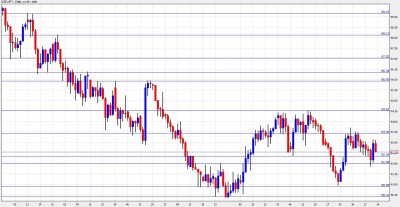Japan’s Rate Decision, Monetary Policy Statement and BOJ Press Conference are the main events this week. Here’s an outlook for the Japanese events and an updated technical analysis for USD/JPY.
Japan’s economy is showing first sign of recovery after the government raised its assessment of the economy for the first time since June. Global demand rise encourages companies to accelerate production. The yen has also retreated from a 15-year high against the dollar reached in November. Will this signal the start of a real recovery for the Japanese economy?
USD/JPY daily chart with support and resistance lines marked. Click to enlarge:
-
Rate Decision: Tuesday. The Bank of Japan decided by a unanimous vote to keep the benchmark rate at 0.0%-0.1% for the third consecutive month and continue buying assets to provide long-term funding, through its 35 trillion yen program. Bank policy makers have also said that increasing the size of the fund would be a clear option if the anticipated slowdown proved deeper than expected. No change in rates is expected.
-
BOJ Monthly Report: Wednesday, 5:00. In its last Monthly report Japan’s government cut its view on exports and business sentiment due to a slowdown in Asia’s economic recovery and a persistently strong yen.
-
Trade Balance: Wednesday 23:50. Japan’s trade balance rose less-than-expected
to a seasonally adjusted 0.43T, from 0.58T in the preceding month.
Analysts had expected the trade balance to rise 0.63T last month. A rise to 0.53T is expected now. -
Household Spending: Thursday, 23:30. Household Spending fell 0.4% in November after a similar drop in October. This figure is worse than the 0.3% rise expected. This economic activity gauge is expected to drop further to 0.5%.
-
Tokyo Core CPI: Thursday, 23:30. Japan’s core consumer prices fell 0.5% in November down for the 21st consecutive month indicating deflation due to weak domestic demand. This decline was somewhat better than 0.6% drop expected. Another drop of 0.3% is predicted.
-
Monetary Policy Meeting Minutes: Thursday, 23:50. In the previous Monetary Policy Meeting Minutes it was said that economy was vulnerable to downside risks as the pace of improvement remained slow and that the BOJ was expected to start asset buying promptly and to take decisive action without delay in response to any changes in economic and financial conditions.
-
Retail Sales: Thursday, 23:50. Retail sales in Japan picked up for the year to November by 1.3%, after a drop of 0.2% in October boosting economic activity. Analysts had expected a rise of just 0.4%. Another rise of 0.7% is forecasted.
-
World Economic Forum (WEF) Annual Meetings: Wed-Sat. WEF annual meetings are held in Davos and attended by central bankers, prime ministers, finance ministers, trade ministers, and business leaders from over 90 countries. The World Economic Forum has offered its annual evaluation of the economic situation around the globe pointing to three major problems: macroeconomic imbalances between the increasing wealth and influence of emerging economies and high levels of debt in advanced economies. Risks of illicit trade, organized crime and corruption and the gravest of all is food and water problem where Crop production cannot keep up with the predicted rise in demand. Most meetings are open to the press and officials usually talk with reporters throughout the day. Comments from central bankers and other influential officials can create significant market volatility.
* All times are GMT
USD/JPY Technical Analysis:
Dollar/Yen managed to hold above the 82.34 line (mentioned last week) before dipping lower. The pair eventually made a recovery and closed at 82.54, a little lower than last week.
Looking down, 82.34 is still a strong line of support, despite the temporary break. It also was a swing low in December. Below, 82 is a minor line now, after working as resistance in October.
Lower, 80.87 is a tough line – it served as support through October and also sent the pair back up a few times in 2011. It’s followed by 80.40, the lowest close ever and by 79.75, the lowest intra-day level, reached back in 1995.
Looking up, strong resistance is found at 83.40 which worked as such in the past two weeks. It also worked in both ways in recent months. Above, 84.50 is the highest level since October and is a very tough resistance line.
Further above, 85.93 was the highest level the pair reached after the big intervention in September. Above, 86.34 and 87.02 were support lines on the way down, and now work as minor resistance.
Strong resistance is found at 88.12, which worked in both direction last summer, and then by 89.15 which capped USD/JPY at that same period
I remain bullish on USD/JPY.
The improvement in the US economy and the weakness of the Japanese one, is likely to translate into a stronger Dollar/Yen, although this pair is always very choppy.
- For a broad view of all the week’s major events worldwide, read the USD outlook.
- For EUR/USD, check out the Euro/Dollar forecast.
- For GBP/USD (cable), look into the British Pound forecast.
- For the Australian dollar (Aussie), check out the AUD to USD forecast.
- For the New Zealand dollar (kiwi), read the NZD forecast.
- For USD/CAD (loonie), check out the Canadian dollar.
